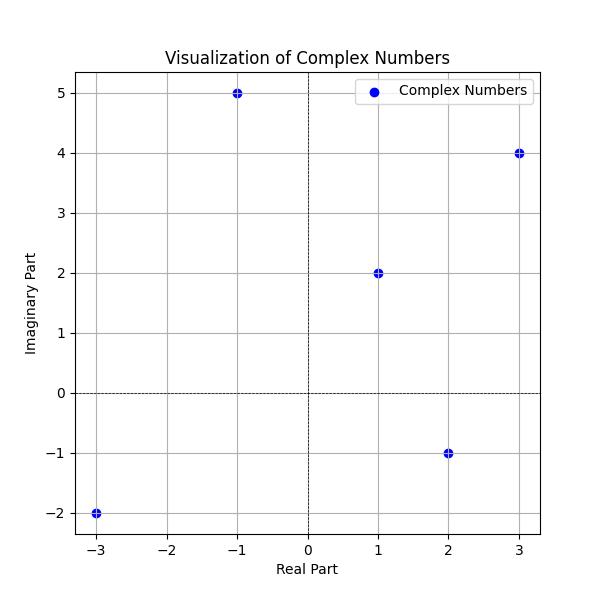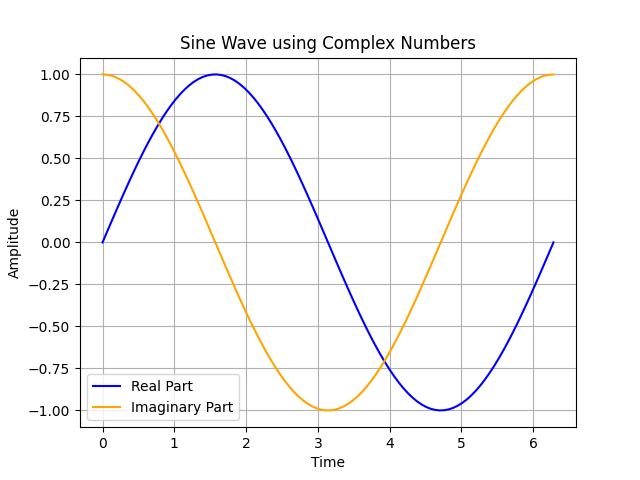complex(): complex number from a real and an imaginary component
real: Required, ( default 0 ) the real part of the complex number. Can be a string input
imaginary: (optional) ( default = 0 ) Imaginary part of the complex number .
We can create a complex number and check the data type by using type()
x=complex(4,3)
print(type(x)) # <class 'complex'>
print(x) # (4+3j)Real and Imaginary parts
We can read real and imaginary part by using real & imag methods. These methods will return float data type.x=complex(4,3)
print(x.real) # 4.0
print(x.imag) # 3.0
print(type(x.imag)) # <class 'float'>
print(type(x.real)) # <class 'float'>x=complex('4+3j')
print(type(x)) # <class 'complex'>x=complex('4+3j',4)Understanding the Complex Number Object in Python
In Python, complex numbers are represented using the complex class. These numbers consist of a real and an imaginary part.
Example 1: Visualizing Complex Numbers
To better understand complex numbers, we can visualize them on a 2D plane. The real part lies on the x-axis, and the imaginary part lies on the y-axis. Here's how we can plot complex numbers using Matplotlib:
import matplotlib.pyplot as plt
# List of complex numbers
complex_numbers = [3 + 4j, 1 + 2j, -1 + 5j, -3 - 2j, 2 - 1j]
# Separate real and imaginary parts
real_parts = [z.real for z in complex_numbers]
imag_parts = [z.imag for z in complex_numbers]
# Plotting
plt.figure(figsize=(6, 6))
plt.axhline(0, color='black', linewidth=0.5, linestyle='--')
plt.axvline(0, color='black', linewidth=0.5, linestyle='--')
plt.scatter(real_parts, imag_parts, color='blue', label='Complex Numbers')
plt.title('Visualization of Complex Numbers')
plt.xlabel('Real Part')
plt.ylabel('Imaginary Part')
plt.grid(True)
plt.legend()
plt.show()Output:

Example 2: Discarding Complex Numbers Conditionally
We can filter complex numbers based on conditions. For instance, let’s discard numbers with a magnitude greater than a threshold:
import math
complex_numbers = [3 + 4j, 1 + 2j, -1 + 5j, -3 - 2j, 2 - 1j]
threshold = 5
# Filter complex numbers with magnitude <= threshold
filtered_numbers = [z for z in complex_numbers if abs(z) <= threshold]
print("Filtered Complex Numbers:", filtered_numbers)Output:
Filtered Complex Numbers: [(3+4j), (1+2j), (-3-2j), (2-1j)]Example 3: Rotating Complex Numbers
Rotation is a common operation for complex numbers, useful in physics and engineering. Rotating a complex number involves multiplying it by another complex number representing the rotation angle:
import cmath
import math
z = 3 + 4j
angle = math.radians(45) # Rotation by 45 degrees
# Rotation
rotated_z = z * cmath.exp(1j * angle)
print("Original Complex Number:", z)
print("Rotated Complex Number:", rotated_z)Output:
Original Complex Number: (3+4j)
Rotated Complex Number: (-0.7071067811865475+4.949747468305834j)Applications of Complex Numbers in Python
- Signal Processing: Complex numbers are heavily used in Fourier transforms and digital signal processing (DSP).
- Electrical Engineering: Useful for representing AC circuits and impedance calculations.
- Physics: Applications include quantum mechanics and wave equations.
- Graphics and Animation: Complex numbers simplify rotation and scaling transformations in 2D graphics.
Code Example: Signal Processing Using Complex Numbers
Here’s an example of how we can generate and visualize a simple sine wave using complex numbers:
import numpy as np
import matplotlib.pyplot as plt
# Generate a sine wave using complex numbers
t = np.linspace(0, 2 * np.pi, 100)
sine_wave = np.sin(t) + 1j * np.cos(t)
# Plot real and imaginary parts
plt.plot(t, sine_wave.real, label='Real Part', color='blue')
plt.plot(t, sine_wave.imag, label='Imaginary Part', color='orange')
plt.title('Sine Wave using Complex Numbers')
plt.xlabel('Time')
plt.ylabel('Amplitude')
plt.legend()
plt.grid(True)
plt.show()Output:

All Built in Functions in Python bin() int() float()

Subhendu Mohapatra
Author
🎥 Join me live on YouTubePassionate about coding and teaching, I publish practical tutorials on PHP, Python, JavaScript, SQL, and web development. My goal is to make learning simple, engaging, and project‑oriented with real examples and source code.
Subscribe to our YouTube Channel here

 Python Video Tutorials
Python Video Tutorials